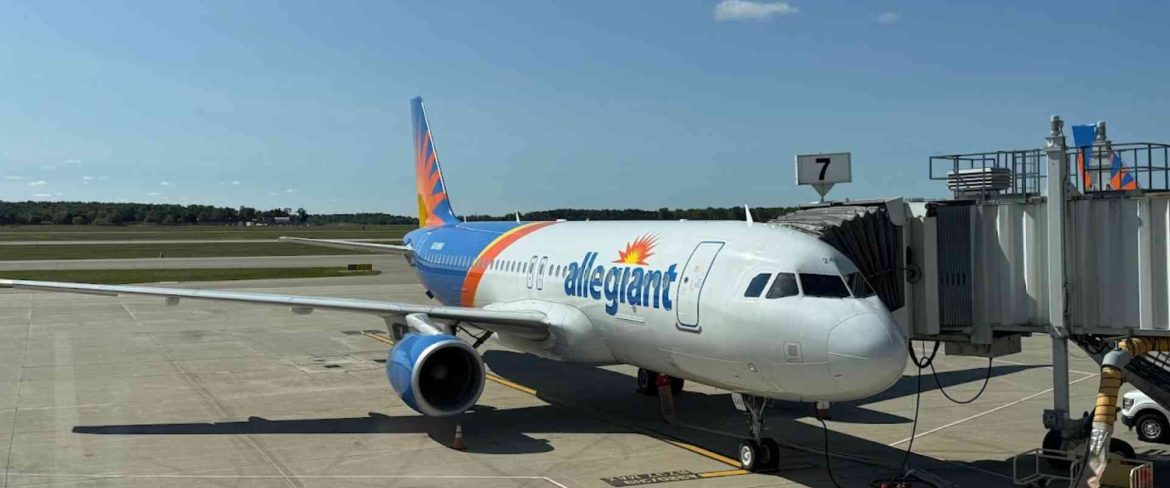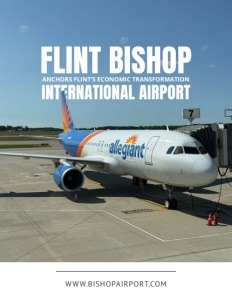Bishop International Airport Anchors Flint’s Economic Transformation
Michigan’s fourth busiest airport is creating jobs and connectivity that fuel regional growth.
Bishop International Airport in Flint was founded in 1928 when banker and General Motors board member Arthur Giles Bishop donated 220 acres of farmland to the city. Since then, the airport has evolved into Michigan’s fourth busiest facility, processing over 300,000 passengers annually. “The airport is positioned strategically between two of the major interstates in Michigan, so you have to pass Flint Bishop International Airport in order to go south or north,” explains Nino Sapone, the airport’s chief executive officer. “We’re in a good location.”
Operating as an ultra-low-cost carrier airport, Bishop International maintains what Sapone describes as a competitive advantage through its cost structure. The facility retired all debt and bonds from its last terminal expansion, enabling it to keep operational costs remarkably low. “Our cost structure is very low to operate out of here. We take pride in that,” Sapone notes. The airport’s two runways, including an 8,000-foot main runway capable of handling Group V and Group VI aircraft, feature modern technology with recent pavement rehabilitation and lighting upgrades completed four years ago.
Allegiant Air anchors the airport’s commercial service as a base operation, housing three Airbus A320 aircraft and employing 88 crew members in a $77 million investment that launched in February 2022. “We have three aircraft and now we’re up to 11 destinations, and growing,” Sapone says. United and American Airlines complement this service with daily flights to Chicago, providing global connectivity through major hub airports.
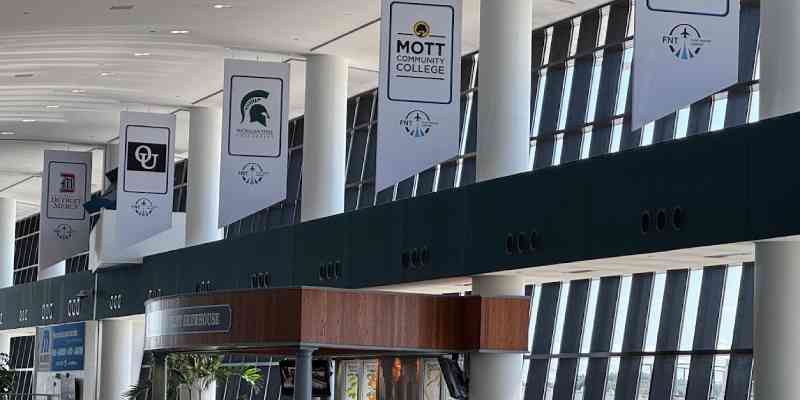
Terminal Modernization and Complete Transformation
Bishop International Airport launched a comprehensive terminal modernization plan in 2023, beginning construction in 2024 with a focus on creating what Sapone calls “a sense of place” for the community. “The current terminal flooring project will display images of Flint, as well as historic landmarks embedded in the terrazzo,” Sapone explains. “When you come into the airport, you’re going to see the cherished elements of the community reflected.”
The terminal roof rehabilitation project includes stripping the membrane down to the structure and rebuilding it with energy-efficient materials. “The project includes new insulation, soundproofing, and a white roof reflective membrane for solar and energy efficiency,” Sapone notes. Phase one was completed last year, while phase two targets the airside terminal. “All casework and ticket counters on both landside and airside have been replaced, and the airport is currently remodeling all bathroom facilities throughout the terminal,” he adds.
Future projects in design will address wayfinding through upgrading signage, digital displays, terminal roadway rehabilitation, and parking lot improvements.
In addition, the airport is exploring covered parking spaces in the terminal lot. Concessions vendor, Tailwinds, will transform the restaurant and bar into a tiki-themed space. “Whenever you
start your vacation here at the airport, it’s going to be like you’re at a tropical destination,” Sapone says. The majority of the terminal modification projects are funded primarily through FAA and Department of Transportation terminal grants, maintaining the airport’s low-cost structure without impacting the rate base.
Aviation Growth and Expanding Operations
Bishop International Airport’s aviation infrastructure supports a diverse mix of operations, including flight training, maintenance, and hangar development. Two flight schools operate on campus: Crosswinds Aviation, which expanded from one aircraft in 2019 to five currently, and Lapeer Aviation. “The flight school is really doing well,” Sapone says of Crosswinds’ growth trajectory. “The schools’ benefit from the airport’s federal grant-funded upgrades to pavement and lighting systems, which maintain modern operational standards across the airfield.”
AeroDesign Services signed a 50-year lease for aircraft maintenance, certification, and overhaul facility in one of the airport’s three major hangars. The company is investing in upgrades with a grand opening scheduled for next month. “Having a Maintenance Repair Operation (MRO) on campus, at the airport, current carriers don’t have to wait for maintenance to be done on the aircraft when they have it right here,” Sapone explains. The MRO facility addresses a critical industry bottleneck where airlines currently face two-year scheduling delays for maintenance checks and complete overhaul.
Future master plan development on a 40-acre parcel of land for hangar development is in the design phase for hangar construction. Currently, a taxiway is in final design to connect the 40-acre parcel to the runway, with construction starting in 2026. “This development will support a wide range of aviation sector jobs and enhance the airport’s capability to attract additional air service.” Sapone notes. The airport is also working with current airlines to add additional destinations, along with attracting new carriers that align with passenger demands.
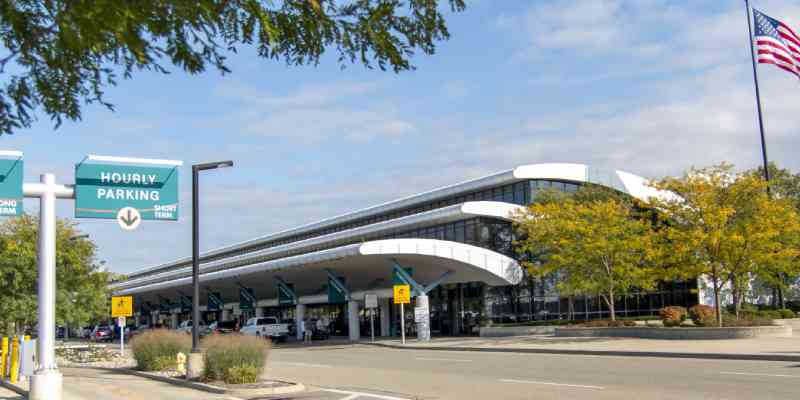
Tourism and Regional Connectivity
Bishop International Airport is an economic gateway with a catchment area of approximately 3.5 million people. It is a broad region of central and southeastern Michigan, encompassing several nearby metro areas and extending to the Canadian border. The airport conducted a second-home study with its aviation consultant, Ailevon Pacific, to identify destination opportunities, leading to recent route additions. “Many of the markets we’ve added recently came directly from analyzing that data,” Sapone explains. “Take Phoenix-Mesa, for example — there is a strong second-home market there for people in our region of Michigan. Jacksonville is similar, and the I-95 corridor overall is a sweet spot for us, with a lot of Michiganders owning second homes along that stretch.”
Passenger numbers indicate sustained growth, rising from 285,000 in 2022 to over 350,000 in 2025, representing a 20 percent increase.
The airport actively cultivates business travel through enhanced Chicago connectivity. Both United and American now operate three daily flights with dual-class aircraft, a service upgrade that enables same-day business trips. “They’ve upgraded the aircraft, which gives you a better product for business travel, with additional frequencies,” Sapone says. The airport works directly
with local business leaders to identify destination needs and provide data to airlines. Canadian travelers also contribute significantly to traffic, drawn by lower fares and convenient highway access that places the airport 90 minutes from the border.
Competitive Advantages
Bishop International Airport’s operational philosophy centers on maintaining one of the lowest cost structures among Michigan airports, a strategy that proved decisive in attracting Allegiant Air’s base operation in 2022. The airport achieved this position by retiring all debt and bonds from previous terminal expansions, freeing capital while keeping per-passenger costs low. “Our cost structure at this airport is among the best in the industry,” Sapone explains. “When you look at our per-passenger and employment costs, we are among the most competitive in the industry. For anyone looking to launch a business or for an airline interested in starting service, getting up and running here is seamless. There’s no major capital investment required, and we take immense pride in keeping our rates low and our business environment easy to work with.”
The ultra-low-cost carrier model aligns perfectly with the airport’s leisure market focus, where vacation traffic to Florida, Las Vegas, and Arizona destinations dominate passenger volumes. Allegiant’s growth from less than seven percent of airport traffic in 2016 to over 54 percent by 2021 and currently 80 percent, keynotes the market’s appetite for affordable leisure travel. The airline’s unique point-to-point network means all three-based aircraft depart from Flint each morning and return by evening, creating what Sapone describes as regular eight-hour workdays for flight crews.
The model created 88 high-wage jobs in the region that previously did not exist, including pilots, flight attendants, and maintenance technicians. The airport’s capital improvement projects proceed without increasing rates, funded instead through FAA and Department of Transportation grants that support terminal modernization while preserving the competitive cost advantage.
Leadership Vision from Pittsburgh to Flint
Nino Sapone arrived at Flint Bishop International Airport with 26 years of experience at Pittsburgh International Airport, where he served as vice president of operations through a transformational period. His background includes a bachelor’s degree in education from California University of Pennsylvania and credentials as an accredited airport executive, along with service as past president of the Northeast Chapter of the American Association of Airport Executives and served on AAAE Board of Directors. “My primary goals are to grow the airport’s air service portfolio, foster economic growth, create employment opportunities and make a positive impact on where I’m at, and that’s why I’m here,” he says.
Pittsburgh’s evolution from a struggling post-industrial city to a thriving hub of medical technology, high-tech industries, and thriving educational institutions provided a roadmap for Flint’s potential. “The Pittsburgh International Airport reinvented itself from being a major hub, primarily serving connecting passengers for US Airways to an originating and destination (O&D) market, where passengers start their travel at the airport and return to the same destination.”
Sapone applies this experience to Flint. Flint has faced well-documented challenges over the years. In meetings with local leaders, he addresses perceptions directly. “I gave my background. I questioned, “What do you think of Pittsburgh?” The first thing they said was, ‘Ah, smog steel town.’ I’m like, yeah, that was probably 20, 25 years ago”, Sapone recounts. “You can’t change your past. You can only change your future and where you’re going.”
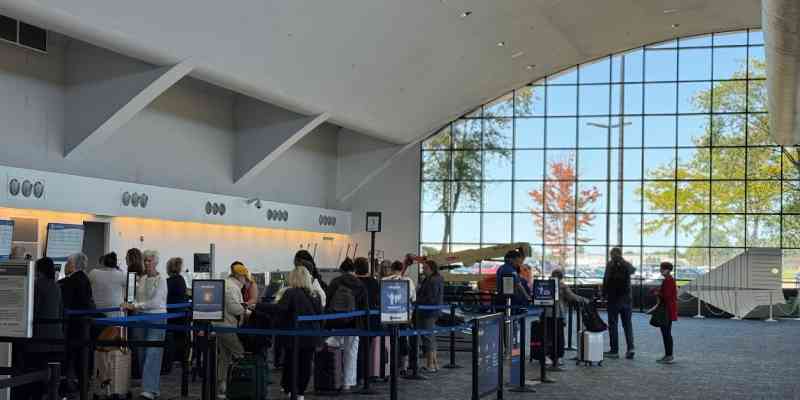
Sustainability and Future Priorities
Bishop International Airport integrates environmental responsibility across its capital improvement program, from LED lighting upgrades funded through utility rebates to advanced water remediation projects. The airport recently partnered with Dynamic Carbon Credits, a local company that evaluates carbon footprints and positions the facility to earn government carbon credits through efficiency improvements. Sapone emphasizes the importance of environmental stewardship in the community. “Sustainability is a high priority for me; to be able to put this airport in the spotlight of what we’re doing is my goal,” he says.
A significant environmental project addresses PFAS contamination. The airport, in cooperation with an FAA pilot program, employs plasma destruction technology to treat groundwater, running it through cycles that remove contaminants before releasing clean water to outfalls. The study, conducted by LimnoTech using DMAX Plasma equipment, uses argon gas bubbles to move PFAS to the water’s surface, where plasma breaks down and destroys the contaminants. “It’s not good for the water, your groundwater. And it is a big push on trying to eliminate the PFAS,” Sapone explains. “The goal is to remove the PFAS or any kind of contaminant and have clean water so you can release clean water to the outfalls.”
Technology improvements include a transition to ticketless parking next month through license plate recognition systems provided by Metropolis. Director of Marketing and Public Relations, Kasey Posa, highlights the sustainability benefits: “Removing ticket spitters means we are not using hundreds of paper tickets each day.” The new system offers a quick registration process and will allow vehicles to enter the airport parking entrance. The system will recognize the vehicle’s license plate. When the vehicle exits, it will again recognize the license plate, and they will be charged upon exit with a receipt arriving via text message.
Looking ahead 18 to 24 months, airport priorities center on supporting current carrier expansion, along with bringing in new air carriers while maintaining competitive cost structures. The taxiway construction connecting 40 acres of developable land will trigger the development of hangar construction. Sapone also revived community engagement through an airshow in June 2024, the first in 35 years, drawing unexpected participation from local RC clubs and generating renewed interest in aviation across the region.
The airport positions itself as an economic generator for Flint’s manufacturing renaissance, creating jobs and connectivity that support the area’s broader transformation from its industrial past into a diverse, technology-driven future.
AT A GLANCE
Name: Flint Bishop International Airport
What: Michigan’s fourth-busiest commercial and general aviation airport
Where: Flint, Michigan
Website: www.bishopairport.com
PREFERRED VENDORS
Kettering University : www.kettering.edu
Founded in 1919 as General Motors Institute, Kettering University blends rigorous STEM academics with up to 2.5 years of full-time, paid Co-op experience. With 570+ employer partners across the U.S. and abroad, Kettering students graduate prepared to innovate, lead, and make an immediate impact.
AeroDesign Services, LLC : www.aerodesignservices.com
AeroDesign Services delivers certified engineering, manufacturing, and MRO solutions across the aerospace, automotive, and transportation. Our FAA Part 21 operation provides precision engineering and manufacturing. Additionally, our FAA Part 145 repair stations in Flint, MI, and Roswell, NM, deliver trusted maintenance and repair services. From aircraft interiors, tooling, and component manufacturing, AeroDesign offers comprehensive end-to-end solutions, spanning concept through production, maintenance, and repair.
Metcalf Electric, Inc. : www.metcalfelectricalinc.com
Established in 2004 with over 25 years of experience, Metcalf Electric Inc. provides licensed, insured commercial and industrial electrical services. A proud NECA and Chamber member, our professional team delivers flexible, design-build solutions that exceed expectations. We’re part of the team that can’t be beat, who are trusted on major projects locally and beyond.
